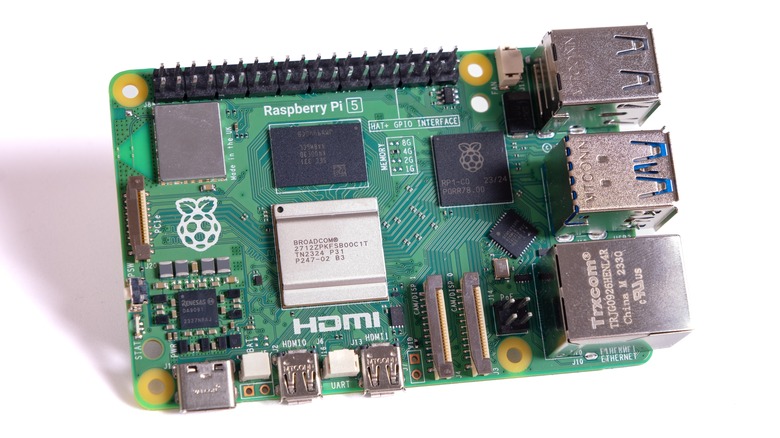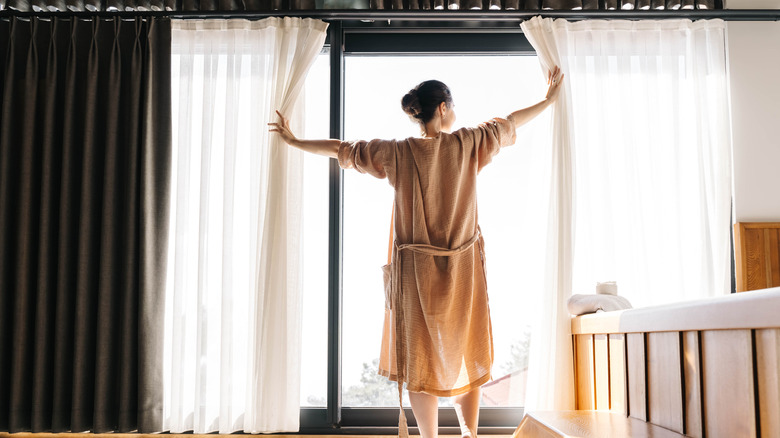5 More Raspberry Pi Projects That Would Be Useful In Your Bedroom
The Raspberry Pi continues to reign as a cheap hobbyist's single-board computer, capable of easy Raspberry Pi projects that only require basic gear, or more complex ones, like a Raspberry Pi AI kit. Virtually anything your imagination can conjure up (within reason) can be made for as little as $5 and a weekend of semi-stressful DIY work. There's a couple of things you should know before buying your first Raspberry Pi, but as long as computers don't scare you, these SBCs can do incredible things by following simple instructions. As proof of how versatile they are, we previously covered five useful Raspberry Pi projects for your bedroom. We're back, this time with even more.
Our previous look at bedroom-oriented Pi projects had the obvious culprits, like a white noise box and an alarm clock. Great projects, but the mighty Raspberry Pi can handle a lot more. Dig deeper, and you can find countless ingenious ideas on YouTube, Reddit, and elsewhere for virtually any use case you can imagine. We found a small handful. This time, we're focusing on more niche, sometimes edge-case projects for things you might need in the bedroom — or things you might find really cool.
Active TV Accent Light
You could make a smart night light with a Raspberry Pi, but that feels a bit too easy. Instead, try a TV accent light. This project comes courtesy of YouTuber bhimmeup, who created an active DIY LED backlight that makes the back of your bedroom TV panel glow against the wall. It also glows in sync with the colors currently output by the TV. It feels like your TV is reaching out of itself into 3D space, creating more immersion while providing utility (keeping you from tripping in the dark) in one package. It's a cheaper alternative to options like the Philips Hue and doesn't require cameras that might infringe upon your privacy.
YouTuber bhimmeup says you'll need a Raspberry Pi, video capture card, some multi-colored LED strips, a micro SD, micro USB-to-USB-A cable, HDMI cables, power supplies for your PI and light strips, one barrel jack connector, and some Dupont wires. If you have multiple devices (Google Chromecast or TV Streamer or game console), then an HDMI splitter is advisable.
Setting it up is pretty straightforward. Load up Hyperion HyperBian onto your Raspberry Pi, and ideally connect it over Wi-Fi via PuTTY to remote-control it. Installing the light strips will depend on your make and model of TV, as will where you mount the Raspberry Pi and capture card. Assuming you follow all the steps with care, the result is nothing short of stunning. The lights automatically create a light show, no further tweaking required.
E-ink Picture Frame with a Weather Forecast
If you're trying to eliminate screens from the bedroom to help you sleep, an e-ink screen is a good choice. YouTuber AKZ Dev has a tutorial showing how you can create a stylish e-ink-screen-in-picture frame that can show the local weather. Only three components are needed: the 7.3 Inky Impression Pimoroni e-ink screen, Raspberry Pi Zero 2 W, and a 5-by-7 frame. AKZ Dev has used this e-ink screen for a whole bunch of projects, and provides a tutorial for building the frame and setting up the initial software side of things.
To source weather data, your Raspberry Pi will do API calls from OpenWeather, which gives you 1,000 free calls per day. Plenty for regular updates. If you get nervous around code, then you're in luck. The entire process can be automated with AKZ Dev's InkyPi web UI interface. You don't even have to calculate your own latitude and longitude, you can just open up the map and drop a pin on your location. The setup also allows you to run your own personalized weather forecast on any screen size you like. If you want something bigger or smaller than the 7.3 inch screen suggested in the build tutorial, the web UI will resize automatically.
Not interested in the weather forecast? AKZ Dev has been cooking up a ton of interfaces for his e-ink screen. Clocks and calendars can be made just as easily, and AKZ Dev appears to be actively creating more.
Automatic Curtain Opener
Automatic curtain openers are nothing new. They're one of many gadgets you can use with a Google Smart Home setup to control them with your phone or your voice, but what if you had curtain openers that opened on their own accord? This GitHub project by LaurenJA does just that, in addition to letting the curtains open/close on demand or on a schedule. We've previously talked to professional reviewers about whether sunrise alarm clocks work, and the evidence is positive.
The light-enabled curtain opener takes only a handful of components. LaurenJA says you'll need a Raspberry Pi 3, sensors, a motorized pulley system, and the included web GUI. Further, you'll need to make your own custom PCB boards, and you're on your own as far as it comes to positioning the sensors and pulley with your own curtains.
A couple of caveats. First, the project was last updated in 2018; there is a chance it simply no longer works. Second, this project leans to the power-user side. There's not much hand-holding, and a lot of technical jargon. Lastly, you could program a normal curtain opener to open and close at pre-determined sunrise and sunset times. If you give it a shot, you'll have some of the coolest, most cost-efficient curtains in the neighborhood. LaurenJA says it's not just for waking with the sun and could be a burglary deterrent. The curtains, in "Home Alone" fashion, will appear to neighbors as if you're the one opening and closing when really out of town.
Streaming Device
There are a lot of benefits to using a streaming device even if you have a smart TV. The problem is choosing the right one. Some, like the Apple TV, limit you with the boundaries of the ecosystem, while others, like Roku, may have ads. There's a third way, however, with fewer limitations and no ads via a Raspberry Pi streaming device. YouTuber Jeff Geerling has a brilliant in-depth tutorial on how to transform a Raspberry Pi 5 into a high-end 4K streamer that can rub shoulders with the best of them.
You'll need an active cooling case, a 27 watt PSU, micro-HDMI-to-HDMI adapter, and a micro SD card with ample space. However, if you're planning to load up a many-hundred-gig library of video content, Geerling recommends an external hard drive. Provided your TV supports HDMI-CEC, you can control your new Pi TV with the manufacturer's remote.
Assembling the Raspberry Pi case is so easy a kid could do it. Then you flash LibreELEC to the micro SD to make the Pi think that it's now a streaming box. Load up your preferred storage device with your media and it's off to the races. Geerling reports some issues with 4K 60FPS video (most 4K video is 30FPS), but overall, this streaming box can handle most content. That includes online videos, like YouTube, and some support for streaming and TV networks. Geerling admits this is a solution more oriented toward those who own their digital content, but it puts you in full control.
Self-Updating Digital Picture Frame
Remember AKZ Dev from the news forecast e-ink screen in a picture frame? One of the many uses he's created for his e-ink screens is an AI art frame. So if you already built the weather forecast frame, you can change it into an AI art frame for your bedroom without too much of a headache. There's no additional hardware required for this version, either.
Just like with the weather forecast e-ink screen, the digital picture frame uses the InkyPi web interface, meaning there's limited coding on your end. There's quite a bit of customization beyond choosing prompts; you can have the system beef up your existing prompt for a better image, or change the orientation to have a picture show vertically. Conversely, you can display text instead of images; for example, an AI-generated dad joke that changes every day. Not a fan of AI-generated content? You can just display your own images.
A couple of things to keep in mind before you go all in on this picture frame. One, this project uses OpenAI's image generator; you'll have to pay for API use if you're not paying for it already, and of course, images cost a lot more than text generation, but generating images on this small screen is pretty cheap. AKZ Dev estimates that you might pay only a couple of dollars a month for daily images. AKZ Dev also notes a strange bug that he hasn't ironed out where borders will appear on the sides at random.

